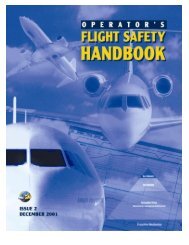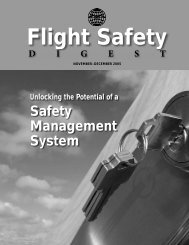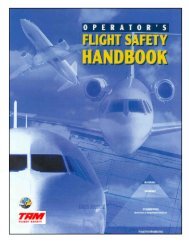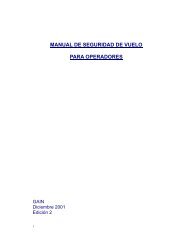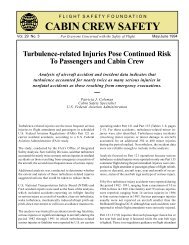Download PDF [10.9 MB] - Flight Safety Foundation
Download PDF [10.9 MB] - Flight Safety Foundation
Download PDF [10.9 MB] - Flight Safety Foundation
Create successful ePaper yourself
Turn your PDF publications into a flip-book with our unique Google optimized e-Paper software.
In summary, if a critical situation<br />
arises during flight operations but an individual<br />
pilot’s brain unconsciously and<br />
involuntarily ignores the cues for threats<br />
presented, then the chances of recovering<br />
are substantially reduced.<br />
Wayne L. Martin, a Boeing 777 first officer for<br />
Virgin Australia Airlines, has submitted a doctoral<br />
thesis on this subject to Griffith University,<br />
Brisbane, Australia. His career includes work in<br />
human factors and airline pilot training, and he<br />
is a member of the International Pilot Training<br />
Consortium Working Group on Training<br />
Practices. Patrick S. Murray, an associate<br />
professor and director of the Griffith University<br />
Aerospace Strategic Study Centre, is a member<br />
of the Line Operations <strong>Safety</strong> Audit Collaborative<br />
currently conducting research on regional<br />
airline safety. His career includes experience as<br />
a military pilot and airline pilot, and in a senior<br />
position at the Australian Civil Aviation <strong>Safety</strong><br />
Authority. Paul R. Bates, an associate professor<br />
and head of aviation at Griffith University, chairs<br />
the Outreach Committee of the International<br />
Civil Aviation Organization Next Generation of<br />
Aviation Professionals Task Force.<br />
Notes<br />
1. Fritz, C.E., and E.S. Marks. 1974. “The<br />
NORC studies of human behaviour in<br />
disaster.” Journal of Social Issues 10 (3):<br />
26–41.<br />
2. Glass, A.J. 1959. “Psychological aspects of<br />
disaster.” JAMA 171: 222–225.<br />
3. Leach, J. 2004. ‘“Why People ‘Freeze’ in<br />
an Emergency: Temporal and Cognitive<br />
Constraints on Survival Responses.”<br />
Aviation, Space, and Environmental<br />
Medicine 75 (6): 539–542.<br />
4. Muir, H.C., C. Marrison, and A. Evans.<br />
1989. “Aircraft evacuations: The effect<br />
of passenger motivation and cabin configuration<br />
adjacent to the exit.” London,<br />
U.K.: Civil Aviation Authority, CAA<br />
Paper 89019.<br />
5. Muir, H.C., D.M. Bottomley, and C.<br />
Marrison. 1996. “Effects of cabin configuration<br />
and motivation on evacuation behaviour<br />
and rates of egress.” International<br />
Journal of Aviation Psychology 6 (1) 57–77.<br />
WWW.FLIGHTSAFETY.ORG | AEROSAFETYWORLD | MAY 2013<br />
6. U.K. Air Accidents Investigation Branch.<br />
1988. “Report on the accident to Boeing<br />
737-236 Series 1, G-BGJL at Manchester<br />
International Airport on 22 August 1985<br />
(Aircraft Accident Report 8/88).” London:<br />
Her Majesty’s Stationery Office.<br />
7. Le Doux, J.E. 1996. The Emotional Brain.<br />
New York: Simon and Schuster.<br />
8. Le Doux, J.E. 2000. “Emotion circuits in<br />
the brain.” Annual Review of Neuroscience<br />
23: 155–184.<br />
9. Carver, C.S., M.F. Scheier, and J.K.<br />
Weintraub. 1989. “Assessing coping<br />
strategies: A theoretically based approach.”<br />
Journal of Personality and Social<br />
Psychology 56 (2): 267-283.<br />
10. Folkman, S., R.S. Lazarus, C. Dunkel-<br />
Schetter, A. DeLongis, and R.J. Gruen.<br />
1986. “Dynamics of a stressful encounter:<br />
Cognitive appraisal, coping, and encounter<br />
outcomes.” Journal of Personality and<br />
Social Psychology 50 (5): 992–1003.<br />
11. Thackray, R.I., and R.M. Touchstone.<br />
1983. “Rate of recovery and subsequent<br />
radar monitoring performance following<br />
a simulated emergency involving startle.”<br />
U.S. Federal Aviation Administration<br />
Office of Aviation Medicine, Report no.<br />
FAA-AM-83-13.<br />
12. Vlasek, M. 1969. “Effect of startle stimuli<br />
on performance.” Aerospace Medicine 40:<br />
124-128.<br />
13. Woodhead, M.M. 1959. “Effect of brief<br />
noise on decision making.” Journal of The<br />
Acoustic Society of America 31: 1329–1331.<br />
14. Woodhead. 1969. “Performing a visual task<br />
in the vicinity of reproduced sonic bangs.”<br />
Journal of Sound Vibration 9: 121–125.<br />
15. Wolfe, T. 2001. The Right Stuff. New York:<br />
Bantam Books.<br />
16. Taleb, N.N. 2010. The Black Swan. New<br />
York: Random House Publishing.<br />
17. Lazarus, R.S., and S. Folkman. 1984. Stress,<br />
Appraisal, and Coping. New York: Springer.<br />
18. Duckworth, K.L., J.A. Bargh, M. Garcia,<br />
and S. Chaiken. 2002. “The automatic<br />
evaluation of novel stimuli.” Psychological<br />
Science 13: 513–519.<br />
FLIGHTTRAINING<br />
19. Zajonc, R.B. 1980. “Feeling and thinking:<br />
Preferences need no inferences.” American<br />
Psychologist 35 (2): 151–175.<br />
20. Lazarus, R.S. 1966. Psychological Stress and<br />
the Coping Process. New York: McGraw-Hill.<br />
21. Monat, A., and R.S. Lazarus. 1991.<br />
Stress and Coping. New York: Columbia<br />
University Press.<br />
22. Martin, W.L., P.S. Murray, and P.R.<br />
Bates. 2010. “The effects of stress on<br />
pilot reactions to unexpected, novel, and<br />
emergency events.” In Proceedings of the<br />
9th Symposium of the Australian Aviation<br />
Psychology Association, Sydney, 19–22<br />
April, 2010.<br />
23. Breznitz, S. 1983. “The seven kinds of<br />
denial.” In S. Breznitz (Ed.). The Denial<br />
of Stress. New York: International<br />
Universities Press.<br />
24. Heaslip, T.W., N. Hull, R.K. McLeod,<br />
and R.K. Vermil. 1991. “The frozen pilot<br />
syndrome.” In Proceedings of the 6th<br />
International Symposium on Aviation<br />
Psychology, Columbus, Ohio: 782–787.<br />
25. Stokes, A.F., and K. Kite. 1994. <strong>Flight</strong><br />
Stress: Stress, Fatigue, and Performance in<br />
Aviation. Aldershot, UK: Ashgate.<br />
26. Simons, R.C. 1996. Boo!: Culture, experience,<br />
and the startle reflex. U.S.: Oxford<br />
University Press.<br />
27. Yeomans, J.S., and P.W. Frankland. 1996.<br />
“The acoustic startle reflex: Neurons and<br />
connections.” Brain Research Reviews 21:<br />
301-314.<br />
28. Asli, O., and M.A. Flaten. 2012. “In the<br />
blink of an eye: Investigating the role of<br />
awareness in fear responding by measuring<br />
the latency of startle potentiation.”<br />
Brain Science 2: 61–84.<br />
29. Jansen, A.S.P., X. Van Nguyen, V. Karpitsky,<br />
T.C. Mettenleiter, and A.D. Loewy. 1995.<br />
“Central command neurons of the sympathetic<br />
nervous system: Basis of the fight or<br />
flight response.” Science 270 (5236): 644–646.<br />
30. Stratakis, C.A., and G.P. Chrousos. 1995.<br />
“Neuroendocrinology and Pathophysiology<br />
of the Stress System.” Annals of the New<br />
York Academy of Sciences 771: 1–18.<br />
| 33


![Download PDF [10.9 MB] - Flight Safety Foundation](https://img.yumpu.com/18550968/35/500x640/download-pdf-109-mb-flight-safety-foundation.jpg)

![Download this Issue [PDF 7 MB] - Flight Safety Foundation](https://img.yumpu.com/18859635/1/190x245/download-this-issue-pdf-7-mb-flight-safety-foundation.jpg?quality=85)
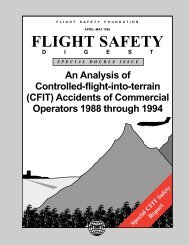
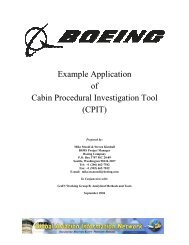
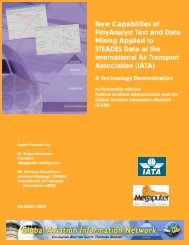
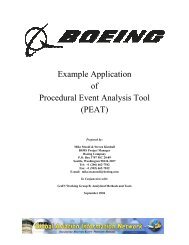
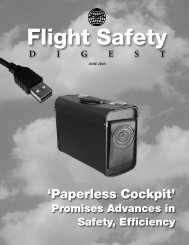
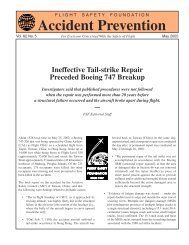
![Download [PDF 8 MB] - Flight Safety Foundation](https://img.yumpu.com/18859366/1/190x245/download-pdf-8-mb-flight-safety-foundation.jpg?quality=85)
